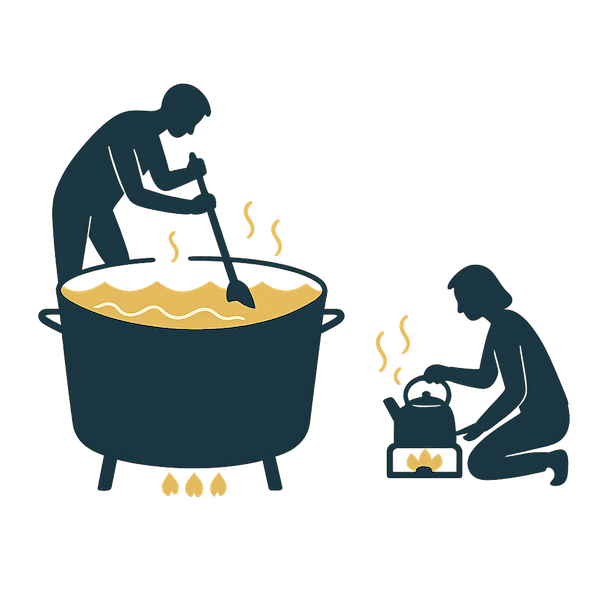The Biggest Mistake Early CPG Brands Make: Going Broad Too Soon
“Product-Market Fit” (PMF) is something you hear in the software world a lot: “Find PMF and then scale.”
It’s just as applicable to CPG companies, but the term isn’t used nearly as much in this industry. Designing your first product for a specific customer and solving their specific problem is almost always a better path to success than building for a broad audience with a general problem.
Make a customer extremely happy with a product better than anything else available to them, and they’ll rave about it to their friends.
Why Going Broad Too Early Is a Mistake
The retail channel is highly scalable, and many brands (including my own) have raised money and gone after a broad target customer in pursuit of topline growth.
The problem? You end up brute forcing your way to scale, trying to please too many people all at once while you’re still a small brand.
It’s easy to get swept up in it if:
Investors are offering you money to chase a mass-market vision.
Retailers are happy to take you on shelves because they don’t want to miss a growing trend.
Sometimes, broad can work—Liquid I.V. is a unicorn in hydration that nailed a mass-market strategy. But most of the real winners I’ve seen succeed by being targeted and clinical about PMF before expanding.
The LMNT Playbook: Product Differentiation + Tight Targeting
LMNT is a great example. They built a truly differentiated product—a stick with 1,000mg of sodium, something no one else was doing.
They found a small customer group first:
People who were fasting
People who were losing weight
After dominating those groups, they layered on adjacent audiences—growing fast and profitably without diluting their brand.
Contrast that with trying to “boil the ocean” by appealing to everyone.
Don’t boil the ocean, its slower and takes way more energy.
Brand Chaos: The Cost of Broad
Going broad adds friction to every marketing decision:
Which influencers do you work with?
What channels should you advertise in?
Which retailers should you be in?
What positioning do you lead with in ads and events?
Your brand strategy starts to fracture. At Hydrant, we had an NFL quarterback, an MMA fighter, an actress, and a Peloton instructor all as influencers—in the same year.
Mixing genders, activities, and use case created brand confusion. Customers never saw a consistent story, and complexity skyrocketed. Who were we for? Who saw themselves reflected in our brand and product?
Differentiation Matters
Product differentiation is central to PMF. You need to be different enough to solve a specific problem for a specific person.
When I started Hydrant in 2017, we were highly differentiated against the incumbents:
Powdered electrolytes were new.
We compared against sports drinks like Gatorade with 27g+ sugar and low electrolytes.
Our formula was simple and clean, with just cane sugar and juice powder.
But as the market matured, Gatorade and other big brands launched zero-sugar sports drinks and powdered electrolyte brands, as well as a flood of new entrants. Our edge eroded fast.
In CPG, with little product protection, owning a niche can be the most powerful defense. Others won’t copy you if:
The market is too small for two players.
Or you’ve already dominated that niche.
How Fundraising Can Pull You Off-Course
Once you raise money, you’re under pressure to find PMF with a much larger audience to justify valuation and return capital.
That means you often ignore small but highly loyal groups because they seem too niche—right when word of mouth could make growth more efficient.
In our case, this tension came to a head with sweeteners.
The Sweetener Pivot (and Losing Core Customers)
For years, our main product was:
Sweetened only with cane sugar.
Light, complex flavor (not overly sweet).
No added colorants, only juice powder for flavor.
A small but vocal group loved it because it avoided all non-nutritive sweeteners. But they were small.
Meanwhile:
Mass market customers wanted sweeter, bolder flavors.
Amazon reviews flagged our taste as a weakness.
Potential acquirers viewed the formula as holding back growth.
So we reformulated:
Added monkfruit (our favorite non-nutritive option).
Boosted flavor intensity without more calories.
Added natural color (beet juice powder, turmeric).
But right after launch, the fundraising market collapsed. We had to pivot from growth to profitability—leaning on retention, not acquisition.
The result?
Our core customers felt abandoned.
We lacked the budget to promote the new formula.
The reformulated product lacked unique differentiation, blending into a crowded market.
When we needed our loyal base most, we’d alienated them.
Niching Down: The Smarter Growth Path
If I were starting again, I’d focus relentlessly on small, highly engaged groups where:
The product is differentiated.
The customers are deeply satisfied.
Grow profitably and deliberately, conquering adjacent markets over time.
It’s healthier than throwing money at mass growth and ending up with a generic product and brand.


